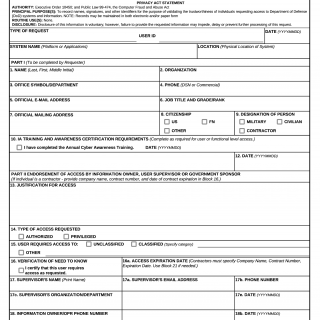DD Form 2875. System Authorization Access Request (SAAR)
The DD Form 2875, also known as the System Authorization Access Request (SAAR), is a document used by military personnel and contractors to request access to classified or sensitive information systems. The main purpose of the form is to ensure that only authorized individuals have access to sensitive information and to protect against unauthorized access or data breaches.
The form consists of several important sections, including personal identification information, system access requirements, system and data sensitivity level, and security clearance information. Other important fields include the purpose of the access, the duration of the access, and the level of access required.
The parties involved in the form include the requester, their supervisor or security officer, and the system administrator or data owner. It is important to consider the specific policies and procedures of the organization or agency when compiling the form, such as the deadline for submission and any additional documentation that may be required.
Data required when compiling the form include the requester's personal identification information, such as their name, rank, and social security number, and their security clearance level. Supporting documents that may need to be attached include a valid security clearance certificate and any additional documentation required by the specific system or data owner.
Application examples and practice and use cases include requesting access to classified databases, systems, or networks, or requesting access to sensitive information related to national security or military operations. Strengths of the form include ensuring that only authorized individuals have access to sensitive information, protecting against unauthorized access, and ensuring compliance with security regulations. Weaknesses may include the potential for errors or incomplete information, which could result in unauthorized access or data breaches.
Alternative forms may include the Personnel Security Questionnaire (SF-86) or the Electronic Questionnaire for Investigations Processing (e-QIP) form. It is important to note that each organization or agency may have their own specific form or requirements.
The form can affect the future of the participants by impacting their security clearance level and their ability to access sensitive information or systems. It is important to submit the form in a timely manner and to ensure that all information is accurate and complete.
The form is typically submitted to the requester's supervisor or security officer, and then to the system administrator or data owner for approval. Copies of the form are typically stored in the requester's personnel file and the system access control records for record-keeping purposes.

